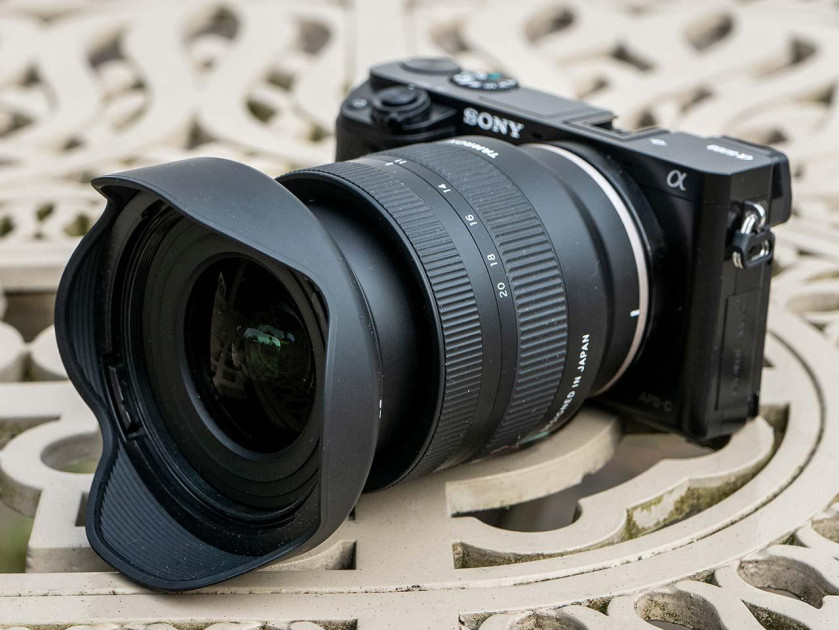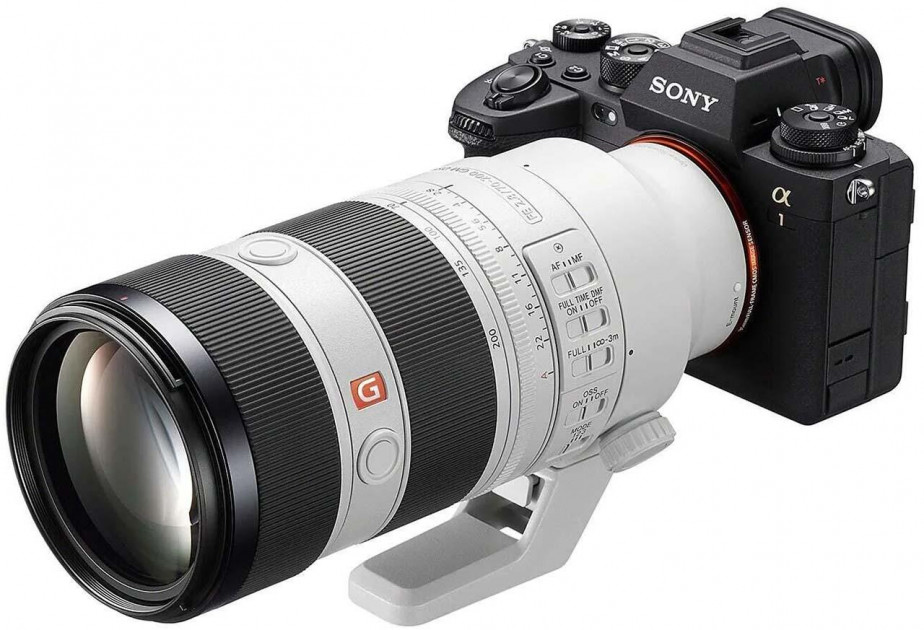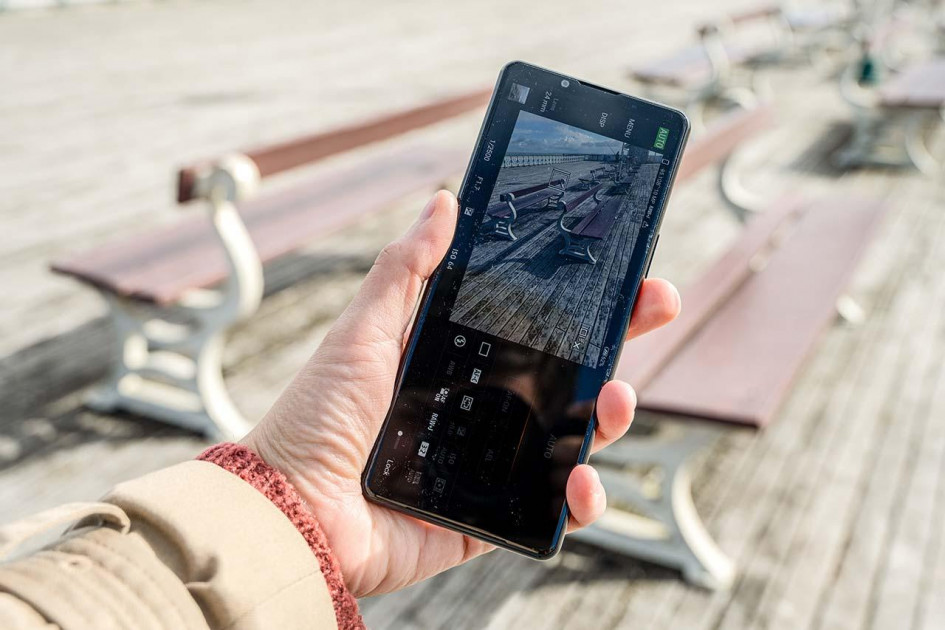
Introduction
The Sony Xperia 5 III follows on from last year’s Xperia 5 II, but also brings many of the same specifications as the Sony Xperia 1 III but in a smaller and cheaper body design.
It was launched in April 2021, but it’s taken until September for it to actually come to market thanks to a variety of different delays in the market.
Sony says that the camera on board the Xperia 5 III takes its inspiration from the company’s range of well-performing and popular Alpha series of mirrorless models. On the rear of the camera is three different camera modules, offering ultra-wide, wide and telephoto optics.
The “main” (24mm, f/1.7) lens uses a larger than average sensor, which Sony says makes it particularly well-equipped for photographing in low light. Although there’s only three cameras, the telephoto lens offers dual lenses, giving you 70mm (f/2.3) and 105mm (f/2.8) to add to your selection. Lastly, there’s an ultra wide (16mm, f/2.2) lens as well.
There’s lots of other photographic-related specifications including Eye AF for both humans and animals, the ability to shoot in raw format, 4K video recording, burst shooting and more. We’ll go through some of these specifications as the review progresses.
Other useful features include 5G connectivity, USB-C charging and a powerful 4,500 mAh battery. The Xperia 5 III runs on the Android operating system (the current version is 11).
Although the Sony Xperia 5 III is designed to be a more affordable version of the company’s flagship option, it’s still not a super cheap smartphone. Currently its retail price is £899, and is available to buy in either black or green with 128GB of inbuilt memory.
Ease of Use
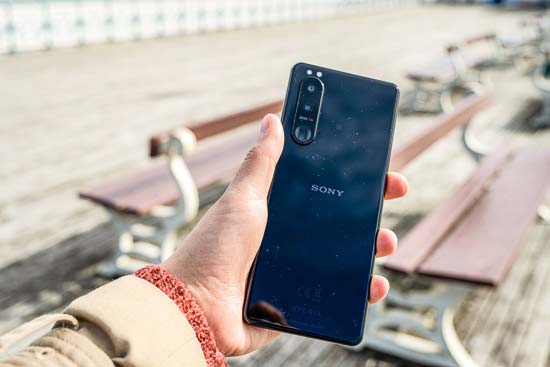 |
In a market which is pretty dominated by large “phablet” style smartphones, the Sony Xperia 5 III feels like it very much stands alone for being smaller and thinner than many of its rivals. Indeed, it’s very similar to its predecessor, the Xperia 5 II which used an almost identical design.
The result is something which fits nicely into your pocket and is comfortable to hold, but can look a little bit strange in comparison to rivals. You also get less screen space for other aspects of a phone experience, such as watching videos or looking at your photos in playback.
That said, it’s arguably neat and stylish, with the rounded edges giving it a very smooth appearance. The black version we were using is also very sleek, with the shine being very pleasing to look at.
 |
As we’ve seen before with this line, and as we see with most other smartphones, the entire of the front of the phone is screen only. There’s no “notch” at the top of the screen, but instead there’s bezels at the top and bottom of the screen. The top bezel houses the front facing camera, as well as a set of speakers.
There are physical buttons on the side of the phone, which can be used to lock and unlock the screen, adjust the volume and if you have the native camera app open to work as a shutter release button. There’s also a button which you can use to switch on or off the phone, which doubles as a fingerprint sensor too.
To open the native camera app, you simply swipe up from the bottom right hand corner of the lock screen. As is common for Android phones, the native app is quite complex and offers a wide variety of different shooting options. By default however, the native app opens in “Basic” mode, which is a good option to use when you just want to grab a quick snap or react to something happening quickly in front of you.
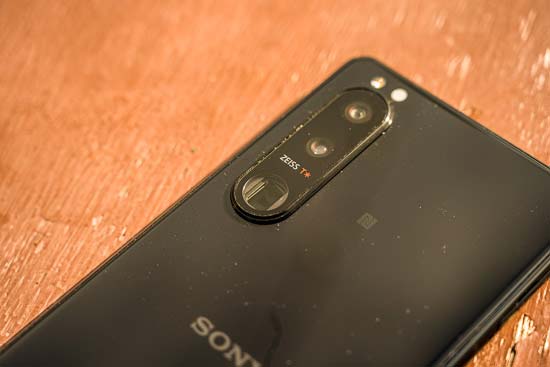 |
In basic mode, you’ll be able to access the four different focal lengths offered by the three different lenses. These are indicated by small circles with x0.7, x1.0, x2.9 and x4.4 inside them. Alternatively you can also pinch to zoom in and out (digitally). You can reach up to x12.5 zoom when using digital zoom.
Also available in basic mode is the option to adjust brightness and saturation, create a shallow depth of field effect (called bokeh here), switch on burst shooting, switch the flash on and off and alter the aspect ratio you’re shooting in. You’ll see at the bottom of the screen there’s a large on-screen shutter button which you can press when you’re ready to take a picture. There’s also a smaller on screen button which enables quick switching between video recording and stills shooting.
Tapping More in the top left hand corner of the screen also brings up a couple of extra options such as “slow motion”, “portrait selfie”, “panorama” and “creative effect”. You can also tap the word “Menu” in the top right hand corner of the screen to bring up a set of other more extensive options, such as Focus mode, switching on the grid lines and so on.
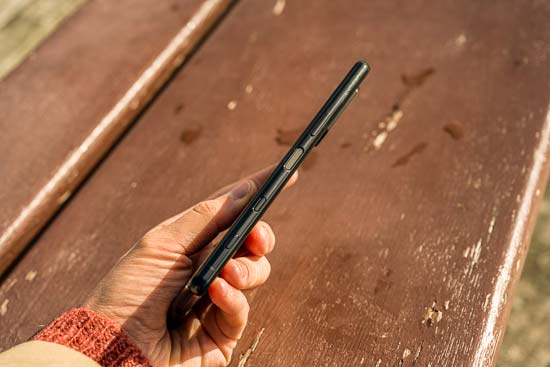 |
You will also see the word “Basic” in the top right hand corner. If you tap this, you’ll see a virtual dial appear at the top of the screen and you’ll be able to switch into the more extensive photo modes, which will make the native camera app look more like a “proper” camera. You’ll also need to switch to one of these options to start shooting in raw format.
The first option here is “Auto” mode, which as the name suggests takes care of all detecting the scene and applying what the camera thinks are the most appropriate settings. You’ll still see a layout like a “proper” camera, and you’ll be able to quickly control certain settings such as AF type, focus area, whether you’re shooting in raw or JPEG (or both) and so on – all directly from the shooting window.
You’ll notice that all of the shooting options / settings are gathered on the right hand side of the screen, when holding the phone in landscape orientation. Unfortunately this means if you want to photograph something in portrait orientation, all of the “buttons” will be the wrong way around. You’ll also find now that switching between the different lenses is accessed via the left hand side of the screen. The biggest difference however is that there’s now no longer an on-screen shutter release button, and instead you now need to use the physical button on the side of the phone.
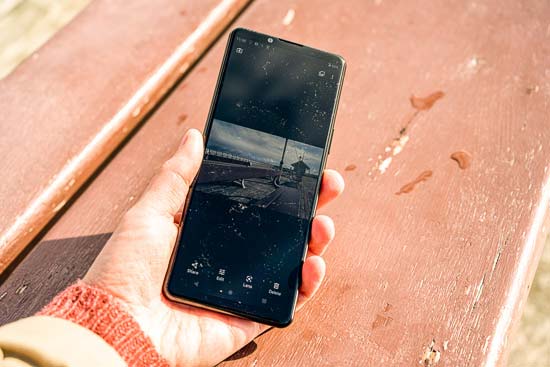 |
If you tap the word “Disp”, also on the left hand side of the screen, you’ll be able to switch on a histogram and also a digital level to help you keep your shots straight.
There are other shooting modes aside from Auto, which advanced or enthusiast photographers might be interested in using. After Auto, you have “P” mode, which stands for “Programme Auto”. With this one, the shutter speed will be automatically decided, but as a user, you have control over other settings, including exposure compensation, ISO, metering and white balance. In this mode you’ll also find you can switch on the DRO (Dynamic Range Optimiser) too, which is something which is seen in Sony Alpha cameras. It’s advised to leave this on “Auto” to provide well-balanced exposures, but you could switch it to “Off” if you’re finding that shots are looking unrealistic.
After “P”, you get “S”, which stands for “Shutter Speed Priority”. With this one you have much of the same flexibility as P Mode, but with the additional option to choose a shutter speed yourself, too. You’ll see the shutter speed options displayed in the top right hand side of the screen and you can simply scroll through to reach the one you want to use. In this mode, you won’t be able to choose an ISO speed yourself.
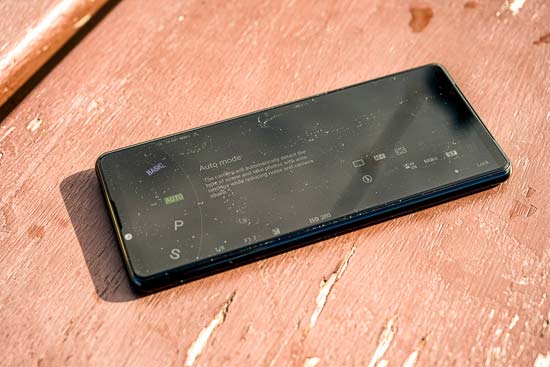 |
“M” mode, is similar to that of a “real” camera, in that you’re given the option to choose all shooting parameters yourself, so that includes ISO and shutter speed. Since the lenses have fixed apertures however, it’s not possible to select that for yourself.
The last option you’ll find in the “mode dial” options is “Memory Recall”, which is a useful option to select if you find yourself shooting in the same kind of conditions relatively frequently, say for example if you’re often shooting in low light and want to up the ISO, or even if you want to often use a certain type of white balance.
Whatever shooting mode you’re in, you can tap on the screen to set a focus point. If you want to photograph a moving subject, it’s worth switching AF-C (continuous AF) and you’ll see an AF box appear on the screen and track the moving subject around the screen. You can also switch on Face/Eye AF, where you’ll notice that the AF box locks onto the eyes of a subject – it works on both humans and animals.
Although it’s possible to record basic video in the native camera app, there is also a “Cinema Pro” app included on the phone that those who are a bit more serious about videography and want to take fuller control. With this app, you can use different “Looks” and change a number of different settings such as resolution, Shutter Speed, ISO and so on. If you’re particularly into vlogging for example, you might want to spend some extra time exploring the options provided by this app compared to the standard camera app.
Image Quality
All of the sample images in this review were taken using the 12 megapixel JPEG setting, which produces an average image size of around 7Mb.
We were impressed by the image quality of the Xperia 5 II, so it comes as no surprise to find that the Xperia 5 III puts in a similarly impressive performance. Left to its own devices, the Xperia 5 III takes some excellent shots, while being able to tweak settings to your own preferences is something that should be appealing to a wide variety of users.
Straight from the camera, JPEG images show a good level of vibrance without going over the top. Exposures are generally well-balanced and colours well-represented. Although you have the option to adjust settings, you might find that in the majority of situations you don’t need to. Being able to shoot in raw format while shooting in the “Auto” mode gives you scope to adjust any problems further in post-production should it be needed, too.
Being able to create pleasing creative effects, such as a natural-looking shallow of depth of field effect is an added bonus. Of course there are myriad apps which you can download for the Android OS to further enhance or edit your shots should you want to get even more creative.
Having four different focal lengths to choose from should also be appealing to many, especially in an era where having a choice of three is the standard. Of the three lenses, the telephoto optics put in the least impressive performance, but all produce good pictures – especially in good light. In low light, the telephoto lens/es are prone to producing slightly softer results than you might ordinarily like, but this is only truly revealed if examining your images very closely.
On the whole, the Xperia 5 III puts in a good performance across a range of situations, producing pleasing results across the board.
Noise
Manual exposure control is possible in the Photo Pro mode (although the aperture is fixed), with an ISO 64-3200 range, plus auto ISO. The ISO setting can be shifted in 1/3EV steps, and we have included identical shots taken at the base ISO and then every full ISO stop between ISO 100 and 3200, that’s almost seven stops in all.
With a maximum aperture between f/1.7 and f/2.8 depending on the lens in use, plus 5-axis image stabilisation, chances are the Xperia 5 III will be set to ISO 64 or ISO 100 via auto ISO the majority of the time. And in good contrast light such as daylight, detail is sharp in these settings.
Certainly, you’ll want to do your best to use ISO 64 or ISO 100 because the adverse effect of noise is progressive with each ISO setting increase. Viewing images at 100% size on screen, detail remains reasonably sharp up to ISO 400, then mushier from ISO 800 and higher.
In low contrast light such as shadows, JPEG detail will be a little mushier than in the brighter areas whatever the ISO setting. Noise is also influenced a little by the lens in use – you’ll get best quality pictures possible by using the primary 24mm lens.
All being said, most images will be viewed on a smartphone or tablet and will appear very sharp up to ISO 800.
| JPEG | RAW |
|
ISO 64 (100% Crop) |
ISO 64 (100% Crop) |
 |
 |
|
ISO 100 (100% Crop) |
ISO 100 (100% Crop) |
 |
 |
|
ISO 200 (100% Crop) |
ISO 200 (100% Crop) |
 |
 |
|
ISO 400 (100% Crop) |
ISO 400 (100% Crop) |
 |
 |
|
ISO 800 (100% Crop) |
ISO 800 (100% Crop) |
 |
 |
|
ISO 1600 (100% Crop) |
ISO 1600 (100% Crop) |
 |
 |
|
ISO 3200 (100% Crop) |
ISO 3200 (100% Crop) |
 |
 |
Focal Range
Three front lenses provide four equivalent focal lengths of 16mm, 24mm, 70mm and 105mm, with the 24mm being the primary lens. Each lens can digitally zoom in, with a maximum reach of 300mm when using the 24mm lens.

16mm

24mm

70mm

105mm
Macro
As with any small-sensor smartphone, the Xperia 5 III has decent macro capabilities. It’s minimum focus distance is approximately 10cm.




Flash
Both in the Photo Pro and the standard camera apps, the flash options are; auto, fill-flash, red-eye reduction, off and torch. Depending on lens choice, app choice and camera settings, not all flash options are available and there are inconsistencies between apps.

Off

On

Redeye Reduction

Off

On
Night
Shutter speed and ISO is automatic in the standard camera app, but in the Photo Pro app those settings can be manually adjusted. The maximum camera settings for night photography is a 30 second shutter speed and ISO 3200.

Sample Images
This is a selection of sample images from the Sony Xperia 5 III camera, which were all taken using the 12 megapixel JPEG setting. The thumbnails below link to the full-sized versions, which have not been altered in any way.
Sample RAW Images
The Sony Xperia 5 III enables users to capture RAW and JPEG format files. We’ve provided some Sony RAW (DNG) samples for you to download (thumbnail images shown below are not 100% representative).
Sample Movies & Video
This is a sample movie at the quality setting of 3840×2160 pixels at 30 frames per second. Please note that this 18 second movie is 118Mb in size.
This is a sample movie at the quality setting of 1920×1080 pixels at 60 frames per second. Please note that this 17 second movie is 61.5Mb in size.
This is a sample movie at the quality setting of 1920×1080 pixels at 30 frames per second. Please note that this 17 second movie is 37.1Mb in size.
This is a sample HDR movie at the quality setting of 1920×1080 pixels at 24 frames per second. Please note that this 17 second movie is 61.5Mb in size.
This is a sample square movie at the quality setting of 1080×1080 pixels at 24 frames per second. Please note that this 16 second movie is 20.1Mb in size.
This is a sample square movie at the quality setting of 1280×720 pixels at 24 frames per second. Please note that this 16 second movie is 25.8Mb in size.
Product Images
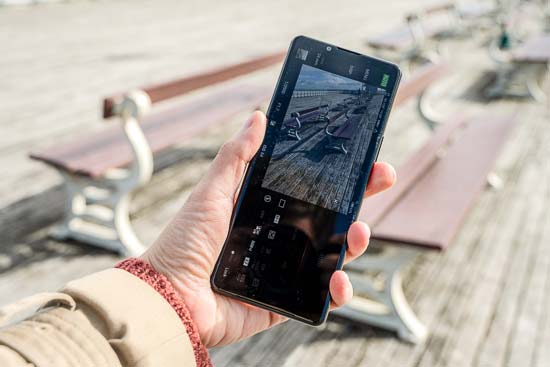

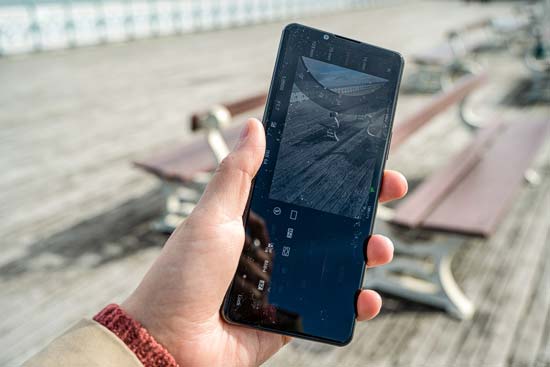


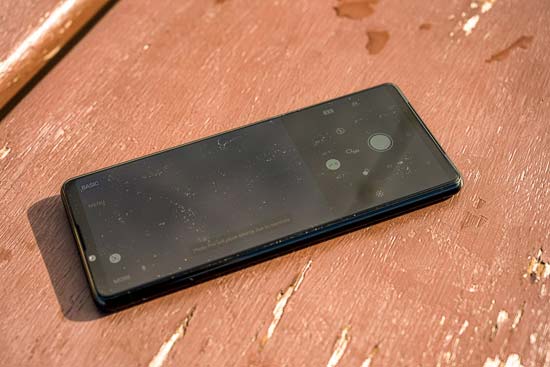

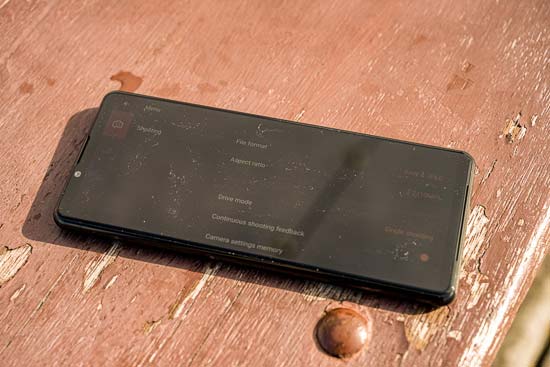
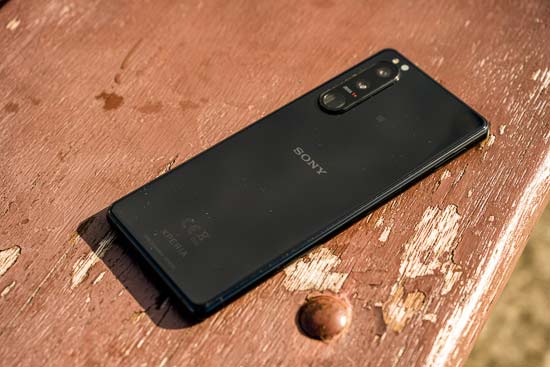

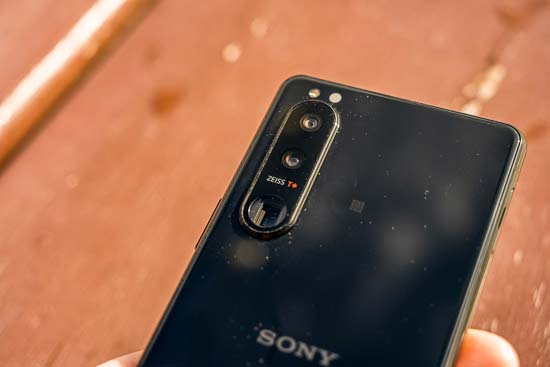
Conclusion
Despite the fact that Sony clearly has some seriously impressive photographic nous in its arsenal, it’s never quite managed to overtake some of the other big players in the current smartphone market.
Although the Xperia 5 III, like its predecessor and like its bigger sibling (the Xperia 1 III), produces some excellent results, there are some niggles to using it which stop short of it being a phone that is truly pleasant to use.
The native camera app is very well-featured, but it’s annoying that the more advanced mode takes up half the screen and assumes that you’ll never want to shoot in portrait format. It’s also a bit of a strange decision to force you to use the physical button on the side of the phone while in these modes, which doesn’t always feel overly natural when working with a smartphone.
Putting that aside, there are some very useful upsides to the Xperia 5 III. Having four different focal lengths to choose from is very good, giving you plenty of flexibility to capture a variety of different subjects. Other aspects, such as Eye AF is great for capturing sharp portraits – even it’s just family snaps – too. That said, the improvement from the previous iteration (the Sony Xperia 5 II) isn’t so great as to demand an immediate upgrade if you already have one, while those who are intrigued by a Sony phone could save some cash by going for the older model.
The smaller size of the Xperia 5 III makes it a little more comfortable to hold in the hand than some of the very large phablet-type smartphones, but, the trade off is that there’s less screen size for displaying your photos, or watching videos in playback.
When it comes to price, last year’s Xperia 5 II was £100 cheaper than the Xperia 5 III, which nudges the latter into the premium territory. At £899 it’s roughly comparable to the iPhone 13 Pro (£950), or the Samsung Galaxy S21+ (£949). It’s harder therefore to recommend it as a “value” option, when other premium phones on the market are in the same price bracket – again though, you could save some money by going for the older version (Xperia 5 II).
Overall, just as we saw with its predecessor, the Xperia 5 III is a good all-rounder, satisfying those who have a desire for a flexible offering without having to have an enormous phone. There are some slight niggles which could be improved to make the phone even better, but it still comes recommended for those who are not seduced by the other bigger players in the market.
| Ratings (out of 5) | |
|---|---|
| Design | 4 |
| Features | 4.5 |
| Ease-of-use | 4 |
| Image quality | 4.5 |
| Value for money | 4 |
Main Rivals
Listed below are some of the rivals of the Sony Xperia 5 III.
The Apple iPhone 12 Pro Max is billed as the ultimate iPhone for photographers, boasting a larger sensor for the main camera, a 2.5x zoom lens and a much bigger screen and overall size than the standard Pro version. With prices starting at around £$1099, is this really the best iPhone for photography? Read our in-depth iPhone 12 Pro Max review now, complete with full-size sample photos and videos…
The Apple iPhone 12 Pro is one of four new iPhones released for 2020, joining the Mini, Pro Max, and the standard model. With prices starting at around £$999, is this the best iPhone for photographers? Read our in-depth iPhone 12 Pro review now, complete with full-size sample photos and videos…
The Pixel 4a 5G is the first Google smartphone with 5G connectivity, but what does it offer the keen photographer? Find out now by reading our in-depth Google Pixel 4a 5G review, complete with full-size sample photos and videos..
The Pixel 5 is Google’s flagship smartphone for 2020, yet it’s priced at just £599 / $699. Does it offer similar performance and features to other, much more expensive range-topping handsets? Read our in-depth Google Pixel 5 review to find out if what it offers photographers, complete with full-size sample photos and videos.
The OnePlus 9 Pro is the latest flagship smartphone for 2021 from OnePlus. Find out if this is the best smartphone for photographers and videographers by reading our in-depth OnePlus 9 Pro review, complete with full-size sample photos and videos.
The Galaxy S21 Ultra is Samsung’s new flagship smartphone for 2021. Featuring a quad-camera setup with 108 megapixels and a 10x optical zoom, 8K video recording, a 5000mAH battery and 5G connectivity, is this the ultimate smartphone for keen photographers? Find out now by reading our expert Samsung Galaxy S21 Ultra review, complete with full-size sample photos and videos…
The Sony Xperia 1 III is a new flagship smartphone for 2021 that has a lot to offer keen photographers and videographers. This includes 20fps burst shooting, real-time AF tracking and real time eye AF for humans and animals, 16mm, 24mm, 70mm and 105mm focal lengths, and advanced Photo Pro and Cinema Pro apps. Read our in-depth Sony Xperia 1 III review, complete with full-size sample photos and videos, to find out if this new smartphone can justify its £1199 / $1299 price-tag…
The Sony Xperia 5 II is a new mid-range smartphone that inherits a lot of the core features from the flagship Xperia 1 II model, in a smaller and more affordable form factor. Read our in-depth Sony Xperia 5 II review, complete with full-size sample images and videos, to find out if this new smartphone can satisfy the serious photographer…
You’ve probably never heard of Vivo before, but that shouldn’t put you off the new X51 5G, one of the best smartphones for photography that we’ve ever reviewed. What makes the Vivo X5 5G so special for both stills and video? Find out now by reading our in-depth review…
Review Roundup
Reviews of the Sony Xperia 5 III from around the web.
The Sony Xperia 5 III successfully scales things back from the lavish Xperia 1 III, with comparable performance and almost equal photographic potential wrapped up in a more compact body. Battery life is even better, too. It’s still lacking in a few fundamental areas, however, and those omissions sting all the more in light of flagship pricing.
Read the full review »
Sony is back with its second 2021 smartphone powered by flagship specifications with the Xperia 5 III. Sony’s more compact smartphone sits as a slightly less expensive alternative to the $1,299 Sony Xperia 1 III while still packing in nearly all the company’s bells and whistles.
Read the full review »
The Sony Xperia 5 III is one step below Sony’s flagship Xperia 1 III, and includes the same camera modules, with a triple 12MP camera system, with an ultra-wide, wide-angle, and dual telephoto setup that gives you both a 70mm and 105mm telephoto lens.
Read the full review »
Specifications
Size
- DIMENSIONS
- 157 x 68 x 8.2 mm
Weight
- WEIGHT
- 168 g
Display
- DISPLAY SIZE
- 6.1″ 21:9 CinemaWide™ display
- DISPLAY RESOLUTION
- FHD+ HDR OLED (2520 x 1080)
- FEATURES
- 120Hz Refresh rate
, 240Hz Motion blur reduction, 240Hz Touch scanning rate
, Creator mode “powered by CineAlta” – Inspired by Master Monitor colour reproduction, DCI-P3 100%, ITU-R BT.2020 (REC.2020), Illuminant D65 White point, 10 bit tonal gradation
, X1™ for mobile
- IMAGE PLAYBACK FORMAT
- JPEG, GIF, PNG, BMP, WebP, WBMP, HEIF, DNG, CR2, NEF, NRW, ARW, RW2, ORF, RAF, PEF, SRW
- VIDEO PLAYBACK FORMAT
- H.263, H.264, H.265, MPEG-4 Video, AV1, VP8, VP9
Durability
- WATER RESISTANT
- Water resistant (IPX5/IPX8)
, Dust proof (IP6X)
- DURABILITY
- Corning® Gorilla® Glass 6
Camera
- CAMERA
- Triple lens camera
Rear Camera (1)
- RESOLUTION
- 12MP
- SIZE
- 1/1.7″ Exmor RS™ for mobile sensor
- APERTURE
- F1.7
- FOCAL LENGTH
- 24 mm
- FIELD OF VIEW
- 82°
Rear Camera (2)
- RESOLUTION
- 12MP
- SIZE
- 1/2.9” Exmor RS™ for mobile sensor
- APERTURE
- F2.3 (70 mm), F2.8 (105 mm)
- FOCAL LENGTH
- 70 mm, 105 mm
- FIELD OF VIEW
- 34° (70 mm), 23° (105 mm)
Rear Camera (3)
- RESOLUTION
- 12MP
- SIZE
- 1/2.5″ Exmor RS™ for mobile sensor
- APERTURE
- F2.2
- FOCAL LENGTH
- 16 mm
- FIELD OF VIEW
- 124°
Camera Features
- FEATURES
- Photography Pro, ZEISS® quality lenses calibrated specifically for Xperia 5 III, ZEISS® T* Coating, Up to 20fps AF/AE
, Up to 60 times per second continuous AF/AE calculation
, Real-time Eye AF (Human, Animal), Object tracking
, Dual photo diode
, RGB-IR, OIS photo
, Photo flash, Photo light, Hybrid zoom 12.5x (based on Wide camera 24 mm), AI Super Resolution Zoom, HDR (High Dynamic Range) photo
- IMAGE CAPTURE FORMAT
- JPEG (.jpg), RAW (.dng)
Video Recording
- FEATURES
- Cinematography Pro “powered by CineAlta”, 4K HDR Movie recording 24, 25, 30, 60 and 120fps slow-motion
, OIS and EIS Video
, Optical SteadyShot™with FlawlessEye™
, SteadyShot™ with Intelligent Active Mode (5-axis stabilization)
, Intelligent wind filter
- VIDEO RECORDING FORMAT
- .mp4 (H.264, H.265)
Front Camera (1)
- RESOLUTION
- 8MP
- SIZE
- 1/4″
- APERTURE
- F2.0
- FIELD OF VIEW
- 78°
- FEATURES
- HDR (High Dynamic Range) photo, SteadyShot™ with Intelligent Active Mode (5-axis stabilization), Portrait selfie, Display flash, Hand gesture
Audio
- HI-RES
- Hi-Resolution Audio, High-Resolution Audio Wireless (LDAC)
- OTHER FEATURES
- 3.5 mm audio jack, 360 Reality Audio
, 360 Reality Audio hardware decoding, 360 Spatial Sound
, Full-stage stereo speakers, Dolby Atmos®
, DSEE Ultimate, Stereo Recording, Qualcomm® aptX™ HD audio
- PLAYBACK FORMAT
- AAC-LC, AAC+, eAAC+, AAC-ELD, AMR-NB, AMR-WB, FLAC, MP3, MIDI, Vorbis, PCM, Opus, ALAC, DSD, Dolby Atmos, Dolby AC-4, 360 Reality Audio Music Format
- RECORDING FORMAT
- AAC-LC , AAC+, AAC-ELD, AMR-NB, AMR-WB
Game
- FEATURES
- PS4 Remote Play
, DUALSHOCK®4 Control compatibility
, Game enhancer
Entertainment
- FEATURES
- Dynamic Vibration System
Memory & Storage
- RAM
- 8GB
- INTERNAL MEMORY
- 128GB UFS
- EXTERNAL MEMORY
- microSDXC support (up to 1 TB)
SIM Capability
- NUMBER OF SIM
- Dual SIM hybrid
- SIM TYPE
- nanoSIM
Operating System
- VERSION
- Android™ 11
Processor
- CPU
- Qualcomm® Snapdragon™ 888 5G Mobile Platform
Battery
- CAPACITY
- 4500 mAh
- CHARGING TYPE
- USB Power Delivery (USB PD) fast charging
- OTHER FEATURES
- Xperia Adaptive Charging, Battery Care, STAMINA Mode
Networks
- 2G BAND
- 850, 900, 1800, 1900
- 3G BAND
- 2100 (Band 1), 1900 (Band 2), 1700 (Band 4), 850 (Band 5), 800 (Band 6), 900 (Band 8), 800 (Band 19)
- 4G BAND
- 1, 2, 3, 4, 5, 7, 8, 12, 13, 17, 19, 20, 25, 26, 28, 29, 32, 34, 38, 39, 40, 41, 46, 66
- 5G BAND
- n1, n3, n5, n7, n8, n20, n28, n38, n40, n41, n77, n78
Connectivity
- WI-FI
- IEEE802.11a/b/g/n(2.4GHz)/n(5GHz)/ac/ax
- LOCATION
- A-GPS, A-GLONASS, Beidou, Galileo, QZSS
- BLUETOOTH
- Bluetooth® 5.2 wireless technology
- USB TYPE
- Type-C®
- USB VERSION
- USB 3.1 Gen1
- OTHER FEATURES
- Smart connectivity, Google Cast, NFC, Output video/image via Display Port support TypeC Cable or USB-C to HDMI Adapter Cable (Display port 4K/60fps)
Sensors
- SENSOR TYPE
- Fingerprint sensor
Accessibility
- ACCESSIBILITY
- Hearing Aid Compatibility (HAC)
, Teletypewriter (TTY)
/SCREEN READERS: Select to Speak, TalkBack, Text-to-speech output /DISPLAY: Font size, Display size, Dark theme, Magnification, Colour correction, Colour inversion, Large mouse pointer, Remove animations /INTERACTION CONTROLS: Accessibility Menu, Switch Access, Click after mouse pointer stops moving, Power button ends call, Auto-rotate screen, Touch & hold delay, Time to take action (Accessibility timeout), Vibration & haptic strength, System navigation /AUDIO & ON-SCREEN TEXT: Mono audio, Audio balance, Caption preferences /EXPERIMENTAL: High contrast text, Shortcut from lock screen


